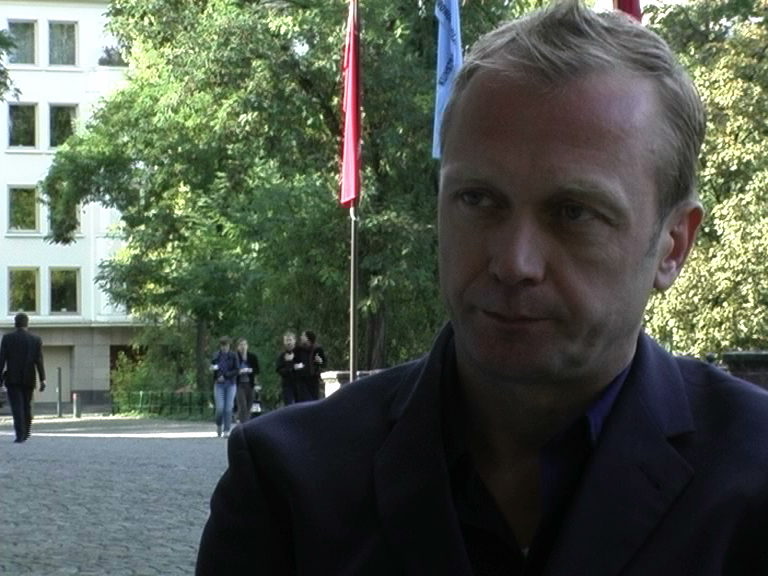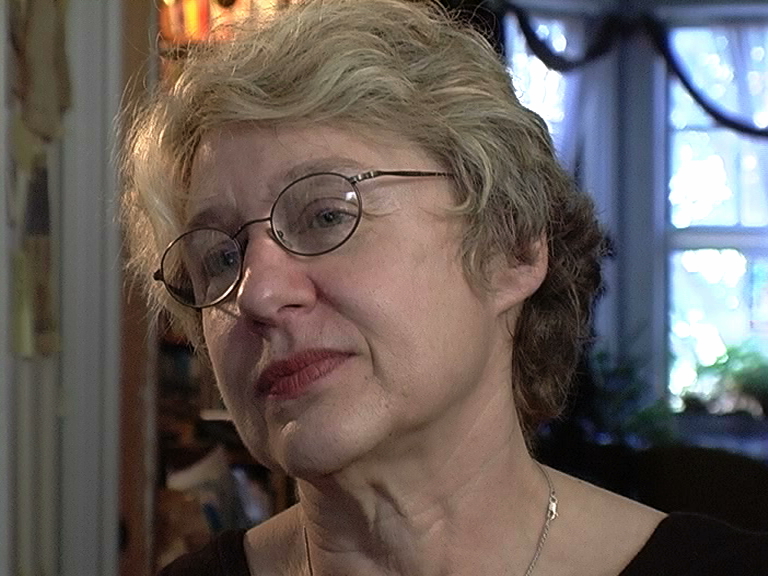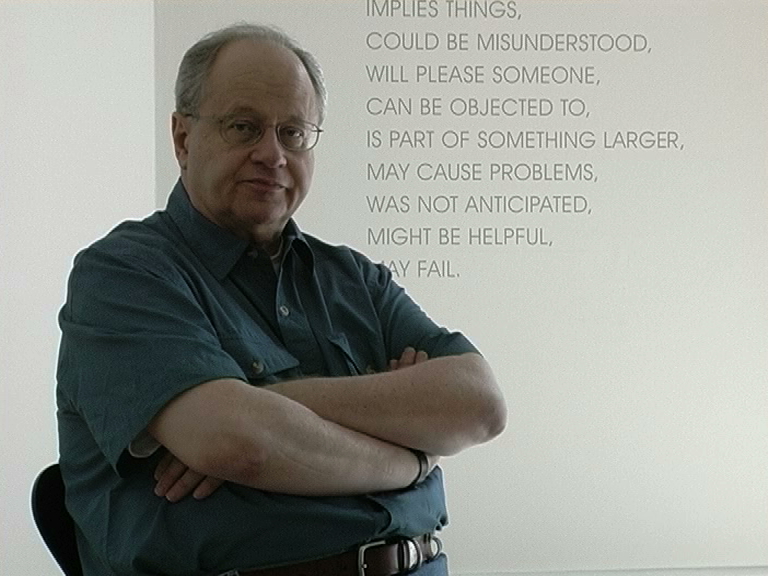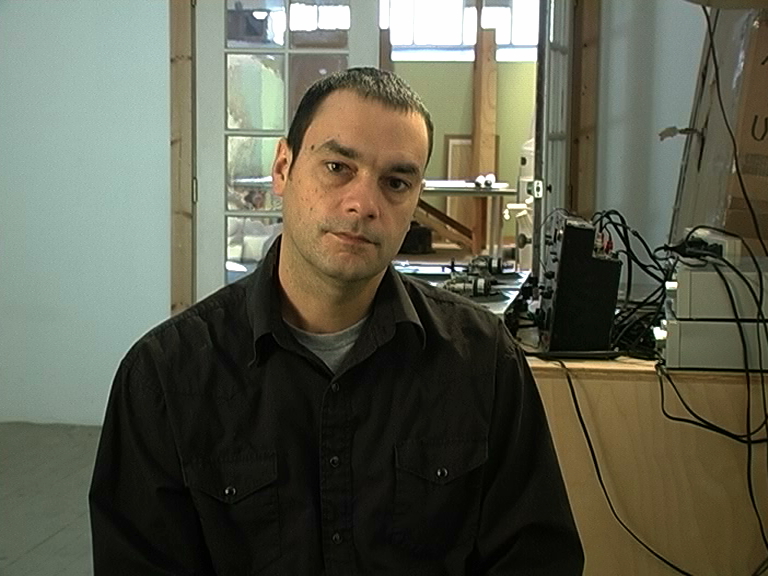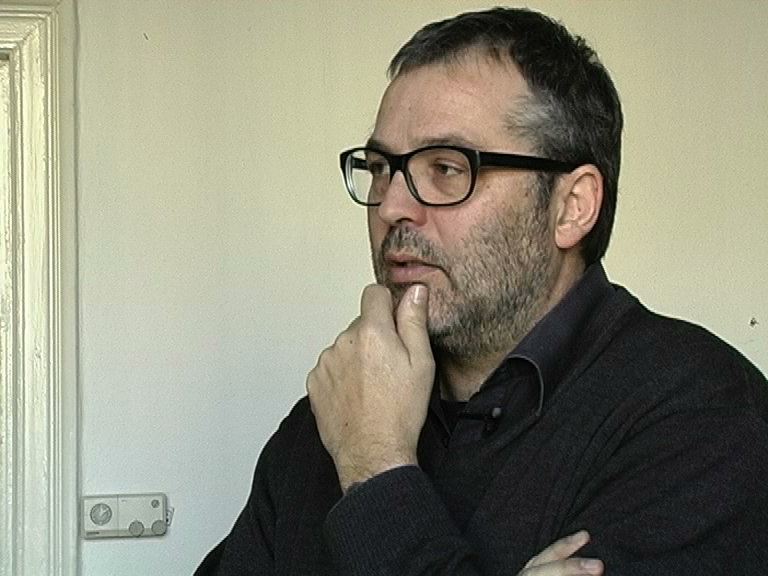S.R.: My first question is how your involvement with art started. How did it come that you were interested in art and specifically in Contemporary art. And when was it?
D.V.: I think that question should be addressed to my husband because I didn’t know anything about art until I met him and he was interested in art and I learned everything from him. So you should really ask him.
H.V.: Well, I think it started in the early 60s.
D.V.: That was when we started, but when you started.
H.V.: O, I started earlier, but when I started it wasn’t in Conceptual art because it didn’t begin then. I am talking about the beginning with Conceptual art, which I believe ran around in 1964.
D.V.: He asked when you started to be interested in art in general.
H.V.: Oh, was that the question?
S.R.: Yes.
H.V.: I am sorry.
S.R.: It doesn‘t matter.
H.V.: It does matter. I did not get it right.
H.V.: I would say in the late 1950s, 56, 57, or maybe a bit earlier. I can’t be precise. But Minimal art wasn’t available then. It was Abstract Expressionism. Everybody was in Abstract Expressionism [cough] at that time – who was interested in art. You had people like Pollock, Kline, Ed Reinhardt a few others. I can’t come up with their names. But that’s when I started. Would that be a satisfactory answer?
S.R.: Yes, sure. But how did it come that you were involved in Conceptual art because your both are known very well in the art world as great collector and supporter of Conceptual art since the 60s.
H.V.: That’s true, we were early on. My wife can answer that. She’s good at that.
D.V. : One of the people Herby knew in the 50s was Sol LeWitt before he was doing conceptual art. When we got married in 1962 we started going to galleries together and one day we saw Sol in a gallery. He said he will have an exhibition, we’d go and see it. Then we went to Dani‘s gallery, Dan Graham was running. Sol had a show there, we really got exposed to Conceptual art. Sol was the one who sent us to Seth Siegelaub‘s generation where we got acquainted with Bob barry, Larray, Weiner, Douglas Hubler and Jospeph Kosuth. We learned about one artist from another. So we met a lot of artists through Dan Graham and through Sol LeWitt. We start going to their studios, start buying their work and that’s what happened.
H.V.: That’s our beginning relationship with Conceptual art and made out of Minimal art.
D.V.: We are lucky that we knew Sol at that point because he was one of the originators and we learned about Conceptual art through him and the other artists. At that time everybody else in the art world would seem to be interested in the Abstract Expressionists; they weren’t interested in anything Minimal or Conceptual. We had no competitors, no one else was buying it, no one else showed interest. These artists were so glad that we came down to their studios, ‘cause we came and looked . They just didn’t get the interest from the people in the United States. They started going to Europe, they started having exhibitions in Germany, in Belgium, in Italy –[Herbert: In Holland]– they build their reputation abroad and as they came back to the United States other Americans started getting interested in their work as well. But we were at the right time at the right place with the right attitude in right context. It just all fit in.
H.V.: We were lucky because now if you get on to a good artist and the corporate people know about it, they out buy you by a mile. We didn’t have that competition. Money wasn’t a big thing then. Now it is.
D.V.: Artists were so glad that we came down to their studio.
H.V.: Just to look; they didn’t even care if you‘re bored.
D.V.: And we did buy, and they appreciated that as well. We started buying more and more until we had a lot.
S.R.: So the interesting thing for me is that in the 60s it must have been possible to collect contemporary art, as you say in a lot of pieces, without a lot of money. ( H.V. tries to interfere) You told me that you were not rich. That‘s different to the contemporary.
D.V. What we did was, we lived on my salary and used his to buy art. So we had a whole bunch of money coming from his job to spend on art. Where as people by themselves can’t do it, but we had two incomes. Also we lived in a very small apartment, so we didn’t spend a lot of money on our apartment. To this day we are not stabilized, It helps us a lot. Even today we live on my pension and we spend his pension on art.
(interruption)
S.R.: So for me the interesting thing is, because I am a much younger generation. I know the art world from a different perspective. I am really interested in, how it was possible that you – as you said, you were not rich people – started to collect contemporary art in such a way, that you bought so many pieces and so many different artists.
D.V.: A lot of Conceptual art is small, they are not huge and monumental. Although you can have if you can get a Sol LeWitt drawing that can be very large, but most of the pieces are pieces of paper, photographs; they are not huge, monumental, big sculptures big paintings. We used my salary to live on and used my husband’s to buy the art. That worked out very well. To this day we live on my pension and use his pension for buying art.
H.V.: In those days money wasn’t as available and as plenty as it is now; at least to rich people and little class. Today money counts beyond anything else first; in my opinion I’m contrasting between now and the 60s. It’s a big difference. I could remember when people like Mark Rothko and Ed Reinhardt they would go to a gallery called Billy Parson’s who was a giant at that time, they were so careful that if they didn’t like me as an artist they didn’t want to show in a gallery; it was not about money (laughs) I remember that very, very well, they cared of how they looked today nobody cares.
D.V.: …of who they showed with, they were associated with.
H.V.: Yes, hope that answers part of your question.
S.R.: How does it work for yourself, as you got more and more pieces, in this small space. How did you start to give parts of your collection to different institutions?
D.V.: We don’t give to different institutions; we only give to the National Gallery of Art so far. That might change but right now it’s still the National Gallery.
H.V.: Which I think is one of the great museums in the world.
D.V.: We couldn’t take care of it all ourselves; just didn’t have the room so we knew we gonna give it to an institution eventually anyhow, so we also wanted to see how they’d be treated. There’s just a lot of good reasons why we started while we’re still alive.
S.R.: When did you start to work together with curators, because you have some exhibitions in different museums?
D.V.: I think our first show might have been in 1972, 1975. In the 70s we had a lot of exhibitions. We even had some in Germany. We had a show in Bielefeld that was curated by … works by Robert Mangold, Sol LeWitt, Bob Barry and Richard Tuttle. We had many exhibitions that travelled. One exhibition that travelled to Finland and Israel, one that travelled around the United States.
S.R.: How was your personal feeling as this private collection, or this part of your private collection, went on through the world?
D.V.: We knew that it was going to go through the world eventually. It’s like children: you have to let them go at one point. We did want to share with people, we did, but we really buy for ourselves. We are the critics, we are the one’s who have to decide if we like it or not. If other people like it: great, but we buy for ourselves; we enjoy sharing it; we cannot put up the works in many cases in the right lighting, the right space, so it’s nice for us to see the works as they should be seen. It’s a big pleasure for us to do that. Another good reason; I really liked the idea that the collection is getting a good exposure because we wanted to get a good home for the collection; the more exposure the more people knew about it the best we can do for the collection. And that’s how we get into the National Gallery. They had never heard of us.
H.V.: The National Gallery in my opinion, going back in time, I feel has a very very extraordinary collection of Renaissance, German works, English works, European works and has now build up through us contemporary works and others. But we started early on to build up the contemporary collection for the National Gallery; we were pretty early on. Before that they were only looking at Europeans that were older: 19th century, 18th century, 16th, what ever. Going back now they buy Serra.
D.V.: We tendency to get a lot of Pop art, sort of, and our collection of course is Minimal, Conceptual, so for Minimal, Conceptual they turned the corner when they accepted our collection because they did have a lot of Pop artists.
H.V.: Which are big in scale although some Minimal art is Serra and others, but Minimal art could be medium size, it could be very large size, but I don’t think it’s very good with Pop artists, the only to that exception is Andy Warhol. The only reason for that: he was a figurative artist at different times in his carreer. Figuration becomes almost normal in size. We are not giants, we are not elephants or, bigger than that, dinosaurs. Again it fitted in with Pop art, but most of the Pop art was like sign paintings that you see outside from a distance, very large.
D.V.: More monumental.
S.R.: So it had a strong relation with Conceptual art for example or some minimal things. They are more something like a mind work or mind art that you had very little pieces but often there were big, big thinking behind that.
D.V.: Yes, a big idea behind it. As you know, we don’t have to execute a piece of art for the conceptual Larry Weiner you have the idea, you don’t have to do it. It’s an easy thing to have in the collection. Some day someone could do whatever it is but you don’t have to. The idea is what’s important.
H.V.: I like to say somethings, which is not your question at the moment. To me people like Bib Barry, William Anastasi and others are not received in this country like people in Europe who are museum people, collectors and involved in the art world of the contemporary field. Europe has been ahead of us in these styles, still continues to do so to a certain extent. We are beginning to catch up, but I do feel and I’m proud of it that Europe was ahead of us.
D.V.: People have often said that Europeans were more into Conceptual art than the Americans. You probably know more than we, a lot of people have discussed it trying to figure out why something in your background, something in your own history accepts it quicker than the Americans.
H.V.: Well, we don‘t have a history of art and we don’t.
D.V.: I don’t know if you’re try to analyse it or not, may be it will come out of your film of how come.
S.R.: Perhaps, yes. It’s not an easy question. I’m not sure if it’s easily answerable with a nationalistic perspective. May be.
H.V.: Not now but early on it was more nationalistic.
D.V.: Even to this day, even Europeans, like you said Robert Barry had some major exhibitions in Europe. He’s not really that much known in the United States.
S.R.: This is very hard for me to understand, because I have a lot of catalogues from Robert Barry and we made the interview by the occasion of his big exhibition in Nuremberg. I think it was half a year ago. Most of the catalogues I have are published in Europe.
D.V.: Yes, that’s right. Yes.
H.V.: It‘s true. That I believe.
S.R.: This is a funny thing. I asked him: how is your reception in the United States and he was not really happy.
D.V.: No, of course not, this is his home country, this is his home city. Naturally – he dosesn’t live in New York, but he lives around New York. You do want to be accepted by your own community and unfortunately this isn’t happening. Sol LeWitt is well-known. Sol is known all over. Richard Tuttle is known, but a certain number of artists that have not gotten their recognition here what it should be. We don’t know why either.
H.V.: Take a man like Richard Tuttle whom I feel is one of the greatest artists of the 20th century. How his style is of the period – although it’s not the style of Conceptual or Minimal – but he is of the time when those periods were at their height and at their innovational point. I would like to know how that’s conceivable, Stefan, can you answer that for me. I’ll ask you a question? That should make it interesting, changes the perspective. I like that.
S.R.: I’m not sure if I can answer that. But I cannot value or what ever, is the working of economic streams, economic interests; I don‘t know if this can answer your question, but in my perspective often artists appear because there is a specific interest in him from a dealer or an art gallery suddenly the gallery loses interest in this artist, maybe the director changes or whatever, and suddenly you don’t see this artist anywhere. Maybe this is one aspect of the big, very complex situation of the art world. The interest for me is in the art world you have relationships between very personal emotions, thinking, ideas to the working of corporate fields, corporate institutions which are working together and are interested in producing capital, are producing cultural capital, are producing producing knowledge. We as individuals only have the possibility to get small insights in this big working thing. Nobody can determine anything, but if you have more cultural – that turned out in the 80s – if you have more cultural power you can push artists, you can push groups, you can work with them internationally, we are influenced by that in reaction, we sign the thing
How is your daily use of the art? And can you say if it changed in the last 20, 30 years? How is your living with the art works? Do you change the walls often or how often do you change the walls?
D.V.: When you change a work of art there is a chance of hurting it in some way. We didn’t really change art that much. Richard Tuttle comes over there frequently; he’s always changing his work around. That was in another spot in the apartment (she points at a work of art). He comes and he does change his own work around, but that is an exception. Generally we don’t move things around too much. They are safer on the wall. Every few years the National Gallery comes and takes more work to the National Gallery. That’s what happens.
H.V.: I would like to generalize and impersonalize. I see the art world all over the world going from personal to impersonal, from individual to corporate. I’m summarizing, epitomizing. I don’t know, Stefan, whether that‘s a good thing or a bad thing, but I do realize now, the number of artists and galleries and museums, have become so difficult to follow, to see that I’m left in a clamour of confusion. What do you think of that?
S.R.: That’s a very precise statement.
H.V: I don’t know but it’s a good statement. I don’t know how precise it is.
S.R.: No, it’s precise, because the interesting phenomenon of the last 20 years, where I could follow it, was that you had times where there were many, many art magazines. Then five years later, six years later you suddenly only have two or three in the differnet country. After five, six, eight years suddenly growing up many different projects, different art magazines – more theoretical or more concentrated on the image. I think it’s very difficult to keep in touch with the development all over the years. Everybody, like you and me, has always a focus it’s getting more and more different when you get older to get in touch and in relationship to other positions. When you grow up in your 20s there is an atmosphere of communication you get information to meet people. It’s very easy. Suddenly you have a stock of information you’re coming to the limits of your memory, your space and your time.
H.V.: And experiences.
S.R.: And experiences. After ten years maybe or fifteen years you have such a big list of adresses, of events where you go to, were you get lots of invitations. So you have to focus on specific things. This is a generation-question. It’s also a question of time, because time in general is speeding up, the communication system is speeding up. May be ten, 20 years ago you didn’t have so much information about art, but there also were many different developments, but maybe you didn’t see that, because you didn’t get the invitation card, you didn’t get the e-mails, so you didn’t know about it. You were not influences by it, it was easier. This is changing. And then you have these high-speed collectors, who have a lot of money and they want to save up, even if they are private or if they’re corporate. They want to speed up their own image; they are travelling around the world. They have their guides. They try to buy very fast, because they always want to be earlier there than others to show it earlier than the others but they are also losing interest earlier e.g. the Sachis threw some artists away in the 80’s, in the beginning of the 90’s.
D.V.: They were sold, didn’t throw them away.
H.V.: I’m having a dialogue with you which I would like you to be a participant, my wife, I or whoever else you would like to include but rather than just us. I’m not greedy, I enjoy the sharing. That’s how I made my collection, didn‘t have that mmoney, I shared. I even share William Anastasi. I think he’s a good artist, I try to help him and I enjoy it, personally but that’s something else. Another thing that‘s is happening, which is very, very contemporary. I don’t know if they do this in Europe. Let’s say there were five or six very wealthy people; they may not primarily be collectors, but they are interested in young artists, very young artists; so the artist could develop in years and style. They are buying a work very cheap; they are putting it together in one project. And they are holding it for a certain amount of time to resell it at a very good price. That’s what they are doing here, I don’t know about Europe. That’s the latest thing. They want someone young, 19, 20, to show not only how early they picked up these artists, but agewise, timewise it’s fascinating. But I don’t know, Stefan, if that is great art. I have to leave that for you.
S.R.: Maybe Katja could say something, because she has a different perspective.
K.S.: What can I say about collectors?
H.V.: When I started the art world in the 50s I used to go out with people, friends, clients, like Franz Kline, David Smith etc. What has changed though, the great change is allowing women, females to be equal to men. When I started that wasn’t in existence: if you were female, if you were good, they didn’t even look at you. If your work was good they still didn’t look at you. If you were a nice person they still didn’t look at you. I like the idea that now there are lots of female artists which are as good as any male artists. That’s a wonderful attribution. Is that true of you Katja?
Katja: It’s still not enough. That’s also what I always try to get in, in this project, more female artists.
D.V.: We’ve always had female artists in our collection.
Katja Schroeder: Yeah, but there are not so many female artist that got recognized ,got noticed.
H.V.: Yeah, that’s true. That’s only very recent, Katja. In the 50s, 60s, you didn’t have a chance if you were female. I don’t know why, but that’s the way it was.
D.V.: We had an exhibition of all our women artists in our collection (…) three years ago (??) many women.
H.V.: I think a lot of women are better than a lot of the guys.
S.R.: I agree. There is a stereotype in the male art world: The stereotype is that if there are women as artists they are feminists. What is wrong. But the interesting thing is, if you have strong female artists, with a strong personality, they often have a very specific kind of working with media. Our problem was, e.g. we asked Shindy Sherman, who has a very strong position. She didn’t want to work in front of a film camera. It’s a pity. Because she could be somthing like a top of a movement. We wanted to meet Louise Lawler; she also has no time. I would like to have more women in this film. We tried to get some more interests.
H.V.: Makes it more interesting.
K.S.: But the male artists were much more willing to be interviewed than the female. It‘s not that we didn‘t try; it was more difficult.
H.V.: Oh, sure. Do you think complaining is better than participating? (laugh)
K.S.: It’s just that their voice is missing again. We have to find a way to get them in without the interview.
H.V.: Here is a woman artist: Linda Bengelis for example is a woman in our collection; I’m being a little partial. Linda Bengelis, her style is not conceptual or minimal. But there is another thing that is important. We have been a bit to specific. Linda Bengelis is not the only one, I use her, because she is been in the collection and of course I want to be a little prejudice. She, in my opinion, is not of the style that you are interesting in, but she is of the period. That’s very fascinating to have the variation and scintillation of that period. In other words: that time in history, there was conceptual and minimal but there were also non-minimal and non-conceptual. I think that’s a fascinating facet.
S.R.: Is she living in New York?
D.V.: No, she lives in New Mexico but she has a place in New York.
H.V.: She would be an interesting artist because she was so early on. And we have about 60 of her works.
S.R.: Really? 60?
H.V.: Yes, and some of the best because I was very close to her. This collection is a very strong one. The National Gallery, they don’t want anything. They’re smart, they got these experts working there and I’m a poor smock. I don’t know anything. Anyway I used her only as an example to make a point just like I’m using Tuttle on a personal level there are other artists of the period I like the idea of mixing the personal with the that’s what makes the period interesting. If you are only stick to conceptual or minimal your are limiting and I‘m trying to be unlimited. (laughs)
S.R.: (laughs) That’s interesting because it’s your personal approach.
H.V.: In our terms of collecting like other collectors all over the world if I buy, Stefan’s or Katja’s work other collectors, they’ll buy too, they wait for me or I wait for them. Dorothy and I, we don’t do that; we buy what we want and what we like. This collection is so individual, it isn’t like everybody else’s collection. There’s no one in the world that has these Tuttles; we have about 70 Sol LeWitts. We are so personal, you don’t realize how personal. In this society we have lost that personal. Maybe not now, may be not in 10 years from now, but eventually the world will look for some individualism; we may come out looking pretty good.
S.R.: That’s a good statement.
H.V.: I hope you like it. I’m trying to give you the best. I’m trying to individualize with you as if I was individualizing myself, whatever you want, I cooperate, I mean that. I’m not trying to hold back for you because I realize what’s good for you is good for us.
S.R.: I had three, four questions, and you answered them very appropriate for us. If there is anything that you want to say, that is very important for you, that comes from your heart, you have the possibility to say it now. Please take your time to think about it.
H.V.: It’s a very wonderful opportunity, but at the moment, I can’t add to because I don’t know what to add to, I don’t want to add for just adding. If you go to movies, six hours doesn’t make it better than one hour sometimes. It’s the same way even in a lecture: people come on and on and on, but they don’t say anything. If someone comes along and talks for three quarters of an hour and it’s very exciting. So I don’t want to bore you.
D.V.: I have some things to add. Some people don’t understand Conceptual art. Somehow they like us, they like our story. They can’t understand what we see in Conceptual art. It’s been a puzzlement to some people who just don’t understand. I see a lot of visual beauty in the Conceptual art that we own; to me it’s a visual experience. I like the idea, but to me it still has to be very visual. People are attracted to different things. So what I see is beautiful other people might not. But to me it‘s a visual experience and I have to have that when we buy a work of art. It has to be something saying to me visually. I do like the idea – don’t get me wrong – because in Conceptual art the idea is primary, but to me the visual is very important as well. I see a lot of beauty in Sol LeWitt, Bob Barry, and to me that’s very important.
S.R.: I thank you very much for this statement because one of the stereotypical critiques of Conceptual art is that it’s not visual.
H.V.: O, come on.
S.R.: I always tell my students for example: you have to look at it, look at it, understand it, think of it, keep it in mind, go again, look at it again. Thank you very much for this statement, it is very important for the film.
We were walking through some years, through some positions. Thank you very much for this great opportunity. It was a great honour for us to be guests in your apartment.


























